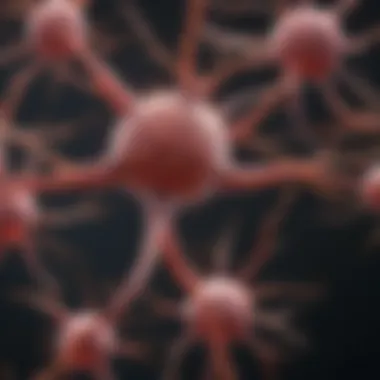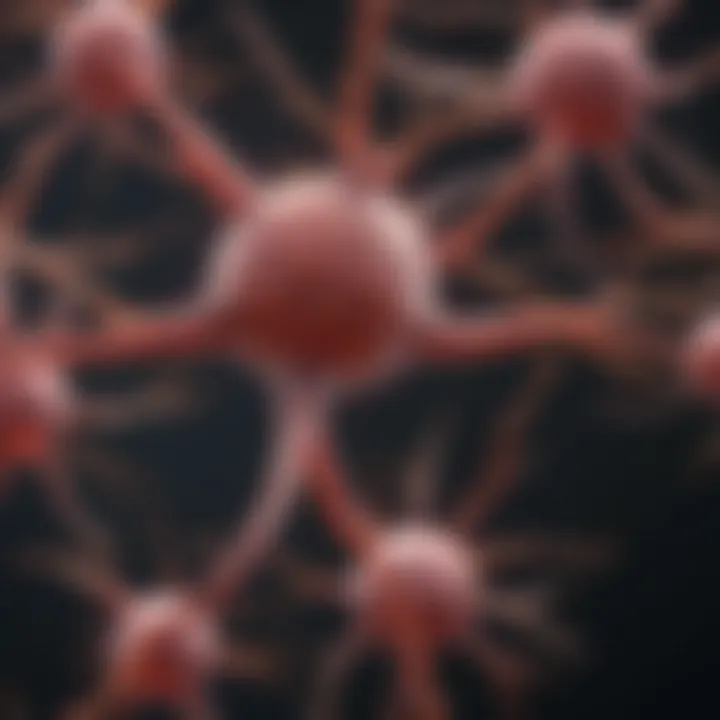Neurotrophy: Understanding Neuron Growth and Health Impact


Intro
Understanding the mechanisms that dictate neuron behavior is foundational to neurobiology. Neurotrophy represents a critical concept in this field, and it encapsulates the processes that underlie neuron growth, development, and maintenance. This article explores the essence of neurotrophy, its relevance to health sciences, and its implications across various medical disciplines. Recognizing neurotrophy's role can illuminate the path towards advancements in treatment options for neurodegenerative diseases and offer insights into therapeutic developments derived from empirical research.
Key Concepts and Terminology
Definition of Key Terms
Neurotrophy can be defined as the biological processes that ensure the survival, growth, and differentiation of neurons. The term encompasses several essential components, including:
- Neurotrophic Factors: These are proteins that promote the survival and growth of neurons. They play a significant role in the development of the nervous system.
- Neuronal Survival: This aspect refers to the mechanisms that prevent neuronal apoptosis, allowing for a healthy nervous system.
- Neuroplasticity: The brain's ability to reorganize itself by forming new neural connections throughout life.
Concepts Explored in the Article
This article will cover multiple aspects of neurotrophy. Key topics include:
- The physiological relevance of neurotrophic factors.
- Their implications in neurodegenerative diseases, such as Alzheimer's and Parkinson's diseases.
- Exploration of current research trends and therapeutic applications in neurobiology.
Findings and Discussion
Main Findings
Research into neurotrophy reveals compelling connections between neurotrophic factors and neuronal health. For instance, brain-derived neurotrophic factor (BDNF) has been found to play a significant role in promoting cognitive functions. Studies have shown that adequate levels of BDNF are associated with improved learning and memory. Furthermore, in diseases like Huntington's, lower BDNF levels correlate with disease severity.
Potential Areas for Future Research
Given the dynamic nature of this field, there are abundant opportunities for future studies. Areas that require further exploration include:
- Therapeutic Approaches: Investigating how neurotrophic factors can be used in therapies for neurodegenerative diseases.
- Impact of Lifestyle: Understanding how factors such as diet and exercise influence neurotrophic factor levels.
- Genetic Factors: Identifying genetic variations that affect neurotrophic signaling and overall neuronal health.
Further exploration into these areas promises to enhance our understanding of neuron function and pave the way for innovative treatments.
By synthesizing the information presented, this article aims to provide clarity on neurotrophy and its multifaceted impact on neurobiology and health sciences.
Understanding Neurotrophy
Neurotrophy represents a critical aspect of neurobiology that has significant implications for health and disease. Understanding this concept enables us to appreciate the complex mechanisms governing the growth and maintenance of neurons. Neurotrophy is crucial not just for neuron survival but also for the overall functionality of the nervous system. It plays an integral role in processes like neurogenesis and synaptic plasticity, which are essential for learning and memory.
The knowledge surrounding neurotrophy allows researchers and practitioners in health sciences to explore therapeutic avenues for various neurological conditions. By learning about the factors that influence neurotrophic processes, healthcare professionals can better understand diseases that affect neuronal health. Consequently, this understanding can also inform the development of interventions that could enhance nerve repair or regeneration, offering great promise for patients experiencing conditions like peripheral nerve injury or neurodegeneration.
In our exploration of neurotrophy, focus will also be given to the biological elements driving these processes. We delve into how growth factors like Nerve Growth Factor and Brain-Derived Neurotrophic Factor contribute to neurotrophy. Each of these pieces of information serves not just to advance scientific inquiry but also addresses pressing questions in both clinical and research settings.
Through this comprehensive overview, we aim to reinforce the significance of understanding neurotrophy in various contexts, from basic research to applied therapeutics.
Defining Neurotrophy
Neurotrophy refers to the mechanisms that govern the growth, survival, and differentiation of neurons. This term encapsulates various biological signals and factors that facilitate the development of the nervous system. The term 'neurotrophy' originates from the Greek words 'neuro', meaning nerve, and 'trophy', meaning nourishment. This highlights the concept that neurons require specific nutrients and signals to thrive and maintain their function.
Neurotrophic factors, which include a range of proteins, act as essential signals for neurons. They bind to specific receptor sites on neuronal cells and trigger a series of intracellular responses. These mechanisms are fundamental to the ability of neurons to adapt and survive under varying physiological conditions.
Understanding neurotrophy, therefore, is essential in the study of neurobiology, as it lays the foundation for comprehensive insights into neuronal health and disease processes.
Historical Context


The concept of neurotrophy has deep roots in neurobiology, tracing back to the late 1950s when researchers began investigating the roles of specific proteins in neuronal survival. Initially, studies focused on the Nerve Growth Factor, discovered by Rita Levi-Montalcini and Stanley Cohen. Their work highlighted how this factor influenced the growth and survival of certain types of neurons.
As research evolved, additional neurotrophic factors were identified, such as the Brain-Derived Neurotrophic Factor and Neurotrophin-3. Each discovery contributed to the understanding of various cellular mechanisms in the nervous system. By the 1990s, increasing evidence pointed to the role of neurotrophic factors in synaptic plasticity, reinforcing their roles in learning and memory.
The historical progression of neurotrophy research reflects a growing appreciation for the complexity of neuronal interactions and the importance of neurotrophic support in both health and disease. This evolving narrative continues to shape modern neurological study, offering insights that extend beyond the laboratory into the development of potential therapies for neurodegenerative conditions.
Biological Mechanisms
Understanding the biological mechanisms behind neurotrophy is essential for grasping how neurons grow and maintain health. Neurotrophy encompasses various factors and signals crucial for neuronal survival, differentiation, and apoptosis. As a field of study, it intersects numerous practices in neuroscience and medicine. Insights into these mechanisms can unlock new therapeutic approaches and enhance our knowledge of neurological diseases.
Growth Factors in Neurotrophy
Growth factors are proteins that play a vital role in cellular growth, survival, and differentiation. In neurotrophy, they are instrumental in providing the necessary support for neurons, ensuring their proper function and longevity. The following are three key growth factors:
Nerve Growth Factor
Nerve Growth Factor (NGF) is one of the most studied neurotrophins. It supports the survival and differentiation of sympathetic and sensory neurons. A key characteristic of NGF is its ability to promote neural plasticity, particularly following injury. This makes it particularly beneficial in research surrounding neurodegenerative diseases and nerve repair.
One unique feature of NGF is its dual role in both promoting neuron survival and regulating apoptosis, or programmed cell death. While its advantages in repair mechanisms are well documented, overdosing or long-term exposure to NGF can lead to adverse effects, such as increased neuronal excitability. This aspect is important in discussing therapeutic uses for NGF in various pathologies.
Brain-Derived Neurotrophic Factor
Brain-Derived Neurotrophic Factor (BDNF) is another pivotal neurotrophin. BDNF has a critical role in long-term potentiation, which is essential for learning and memory. One major quality of BDNF is its widespread expression in the brain, making it relevant in many areas of neurobiology.
In terms of uniqueness, BDNF’s involvement in synaptic plasticity stands out. It enhances communication between neurons by facilitating synapse formation and maintenance. Unlike NGF, BDNF is also implicated in mood regulation, making it a popular focus in studies related to depression and anxiety. However, elevated levels may also correlate with certain pathologies, raising questions about its regulation.
Neurotrophin-3
Neurotrophin-3 (NT-3) has essential roles in the development and maintenance of the nervous system, particularly for proprioceptive and sensory neurons. Its key characteristic lies in its ability to enhance neuronal survival during development and in response to injury.
NT-3's unique feature is its ability to bind and activate specific receptors in a targeted manner, leading to precise cellular effects. This trait highlights NT-3’s potential in therapeutic contexts, especially in improving recovery from peripheral nerve injuries. However, like the other neurotrophins, the challenges of dosage and timing in therapeutic use must be considered to avoid complications.
Role of Neurotrophic Signals
Neurotrophic signals facilitate communication between neurons and their surrounding environment. They provide essential support for not just the physical health of neurons, but also their functional capabilities. The signaling pathways activated by these signals are crucial for neuronal adaptation to challenges such as injury or stress.
Neurotrophic signals play an undeniable role in shaping the neural network and are vital for advancing therapies for neurodegenerative disorders.
These signals are the means through which neurons communicate their needs and respond to external signals, ensuring optimal function and survival.
Understanding these biological mechanisms can offer deeper insights into neuroplasticity and innovation in treatment strategies for a variety of neurological conditions.
Neurotrophy in Health and Disease
The study of neurotrophy plays a critical role in understanding how properly functioning neuronal systems can contribute to overall health. The mechanisms by which neurotrophic factors operate are not just imperative for development but are also fundamental to maintaining neuronal integrity throughout life. This section discusses the normal physiological functions of neurotrophy and its particular significance in neurodegenerative disorders.
Normal Physiological Functions
Neurotrophy is essential for various normal physiological functions. The regulation of neuron growth, survival, and differentiation relies heavily on neurotrophic factors. These proteins help preserve the function of neurons by providing the necessary nutrients and support. Without adequate neurotrophic signaling, neurons may begin to degenerate, which can lead to a number of neurological issues.
Key functions include:
- Promoting neuronal survival: Neurotrophic factors ensure that neurons can withstand stressors and resist apoptosis, or programmed cell death.
- Facilitating synaptic plasticity: This refers to the ability of synapses to strengthen or weaken over time, which is crucial for learning and memory.
- Fostering axonal growth and guidance: Neurotrophy is vital during development as well as in cases of injury, assisting in the proper routing of neuronal connections.
Thus, neurotrophy is not simply about growth; it shapes how neurons connect, communicate, and respond to their environment.


Neurotrophy in Neurodegenerative Disorders
Neurodegenerative disorders present a challenging landscape where neurotrophic factors play a significant role in disease pathology and management. These diseases often involve progressive loss of structure or function of neurons, and understanding neurotrophy may offer insights into therapeutic approaches.
Alzheimer's Disease
In Alzheimer's Disease, there is a notable decline in neurotrophic support, particularly with Brain-Derived Neurotrophic Factor (BDNF). This decline is linked to the cognitive deficits characteristic of the disease. The key characteristic of Alzheimer's is the accumulation of amyloid plaques and tau tangles. This unique feature contributes to the neurodegenerative process by disrupting neuronal communication and function. The significance of studying Alzheimer’s lies in the potential to enhance neurotrophic signaling as a therapeutic strategy. Improving BDNF levels could help mitigate some of the cognitive decline, making it crucial for research in neurotrophy.
Parkinson's Disease
Parkinson's Disease is associated with the loss of dopamine-producing neurons in the substantia nigra. Here, neurotrophic factors can be particularly beneficial. They may promote the survival of remaining neurons and encourage the regeneration of dopaminergic pathways. The distinct aspect of Parkinson's is the role of oxidative stress and inflammation in the degeneration of neurons. This understanding highlights how neurotrophic therapy could serve as a potential intervention. Research into using neurotrophic factors, such as Glial-Derived Neurotrophic Factor (GDNF), is promising for preserving neuronal function and even improving motor symptoms.
Multiple Sclerosis
Multiple Sclerosis presents a complex scenario where the immune system attacks the central nervous system, leading to demyelination. In this context, neurotrophy becomes critical as it may not only promote nerve regeneration but also protect against immune-mediated damage. A noteworthy characteristic of Multiple Sclerosis is the variable course of the disease, which can include relapses and remissions. Here, understanding the neurotrophic response could unlock potential avenues for restoring myelination and neuronal health. Clinical approaches that enhance neurotrophic support might help patients experience fewer relapses and better overall function.
Given the varied impact of neurotrophy in different neurodegenerative disorders, it is evident that addressing neurotrophic signaling can lead to better management and potential treatments for these complex diseases. This creates avenues for further research focusing on identifying specific neurotrophic factors and their mechanisms of action in disease contexts.
Therapeutic Applications of Neurotrophy
Therapeutic applications of neurotrophy hold significant promise in the realms of medicine and neurobiology. The understanding of neurotrophic factors and their mechanisms can lead to advancements in treatments for various neurological conditions. By leveraging the natural growth and maintenance signals that neurotrophy provides, researchers can explore new avenues for enhancing neuronal health. This may improve patient outcomes in disorders ranging from neurodegenerative diseases to traumatic injuries.
Regenerative Medicine
Regenerative medicine focuses on repairing or replacing damaged tissues and organs. Neurotrophy plays a pivotal role here by stimulating the regeneration of neurons. It helps harness the body’s own repair mechanisms. For instance, after a spinal cord injury, the application of neurotrophic factors can encourage axonal growth, facilitating recovery of function. The use of these factors presents a beacon of hope for conditions previously deemed untreatable. Despite its potential, challenges remain in delivering these therapies effectively in clinical settings.
Neurotrophic Therapies
Gene Therapy
Gene therapy involves altering the genetic material within cells to treat disease. By integrating genes that encode neurotrophic factors, this approach aims to enhance neuronal survival and promote regeneration. A key characteristic of gene therapy is its ability to provide a long-lasting effect by permanently integrating therapeutic genes into the patient’s genome. This makes it a highly advantageous option for treating chronic conditions.
However, gene therapy also has drawbacks, such as potential immune response or unexpected genetic interactions. These risks require careful consideration when developing treatment protocols. Its promise lies in its capacity to provide targeted and sustained neurotrophic support in patients, thus helping restore lost function in neurodegenerative diseases.
Drug Development
Drug development in the context of neurotrophy focuses on creating pharmacological agents that mimic or enhance neurotrophic signaling. One prominent aspect of drug development is the search for compounds that can cross the blood-brain barrier effectively. A key characteristic of many potential drugs is their specificity in targeting specific neurotrophic factors, which can provide a more focused treatment strategy.
The unique feature of this approach lies in the ongoing discovery of small molecules that can modulate neurotrophic pathways. This method shows promise as it could offer a more accessible treatment compared to gene therapy. Nevertheless, drug development also faces limitations regarding long-term efficacy and safety that must be addressed in clinical trials.
Current Research and Clinical Trials
Current research and clinical trials in the field of neurotrophy are actively exploring new interventions and therapeutic models. > "Research is crucial for translating the science of neurotrophy from bench to bedside."
Clinical trials are increasingly focusing on the application of neurotrophic factors in various contexts, including neurodegenerative disorders like Alzheimer’s disease and traumatic brain injury. The outcomes of these studies will provide critical insights into the effectiveness and safety of neurotrophic therapies, transforming our understanding of their role in therapeutic applications.
Challenges in Neurotrophy Research
Research in neurotrophy faces numerous hurdles that inhibit scientific progress. Understanding these challenges is crucial for enhancing the efficacy of treatments related to neurotrophic factors and their roles in health and disease. Identifying methodological limitations, ethical considerations, and the impact of these challenges can shape future research directions and therapeutic strategies.
Methodological Limitations
Methodological limitations often arise from the complexity of biological systems. In neurotrophy research, isolating specific factors that influence neuron growth and development can be difficult. Often, traditional models do not fully replicate human physiology, leading to results that may not translate effectively to clinical settings.
For example, many studies rely heavily on animal models, which can yield insights but also have significant limitations. Factors such as species differences in neurotrophic signaling pathways may distort the applicability of findings to human biology.


Moreover, variability in experimental design can complicate the interpretation of results. Studies frequently differ in methodology, sample sizes, assessment techniques, and analysis approaches. This inconsistency makes it challenging to compare studies and draw definitive conclusions about neurotrophic processes.
To address these limitations, researchers must strive for standardization in experimental protocols and increase transparency in methodology. This could facilitate better reproducibility and comparability of results across studies.
Ethical Considerations
Ethical considerations play a significant role in neurotrophy research, particularly when involving human subjects or animal models. The pursuit of knowledge in neuron growth and related therapies must be balanced with moral obligations to protect participants.
In clinical trials, ensuring informed consent is essential. Participants must fully understand the risks and benefits of the research. This is particularly complex in studies involving neurodegenerative disorders where cognitive impairment may affect decision-making capacities.
Furthermore, when employing animal models, researchers need to uphold humane treatment guidelines. For instance, researchers must justify the necessity of animal use and minimize suffering. Ethical review boards are instrumental in evaluating the proposed research methods for compliance with ethical standards.
Engaging with these ethical considerations not only safeguards the welfare of subjects involved but also enhances the credibility of the research. Investors and funding bodies are more likely to support studies that demonstrate a strong commitment to ethical practices.
In summary, facing challenges in neurotrophy research is vital for advancing the field. Addressing methodological limitations and ethical considerations can lead to more robust findings and trustworthy applications in health sciences.
Future Directions in Neurotrophy Studies
The field of neurotrophy presents an evolving landscape filled with opportunities for research and application. Understanding future directions is crucial for students, researchers, and professionals looking to make significant contributions. Innovations in neurobiology are expected to provide deeper insights into neuron function and development. These advancements will help in addressing challenges in neurodegenerative diseases and could lead to novel therapeutic strategies.
Innovative Approaches
Biomarkers
Biomarkers are essential in assessing neurotrophic responses and provide insights into neuronal health. They represent measurable indicators of biological processes that can signify the state of neurotrophy. The key characteristic of biomarkers is their ability to reflect real-time changes in neurons, making them useful in both clinical and research settings. Due to their sensitivity and specificity, they are a popular choice in neurobiology studies.
Unique features of biomarkers include their potential for identifying disease progression and therapeutic effectiveness. For example, measuring specific proteins related to neurotrophy can help monitor conditions such as Alzheimer's disease. Advantages of using biomarkers lie in their non-invasive nature, as they often require only blood or cerebrospinal fluid samples. However, disadvantages may arise from the variability in expression due to individual differences, necessitating robust validation in diverse populations.
Advanced Imaging Techniques
Advanced imaging techniques, such as functional MRI and PET scans, play a pivotal role in the future of neurotrophy studies. These methods enable researchers to visualize neuron activity and track the progression of neurotrophic factors in real-time. The key characteristic of these imaging tools is their ability to provide spatial and temporal resolution of brain activity.
One unique feature of advanced imaging techniques is their capability to highlight neuroplasticity—the brain's ability to reorganize itself by forming new neural connections. This feature offers significant advantages in understanding how neurotrophy can be influenced by external factors and therapies. However, challenges include high costs and the need for specialized expertise, which may limit accessibility for some research teams.
Interdisciplinary Perspectives
Future studies of neurotrophy increasingly benefit from interdisciplinary perspectives. Integrating neuroscience with fields such as biotechnology, data science, and pharmacology can lead to enhanced understanding and innovative solutions. This collaborative approach enriches the research landscape and opens up new avenues for advanced therapeutic interventions.
Research teams that incorporate diverse expertise tend to produce more holistic findings. Such collaborations can foster development of new strategies for diseases linked to neurodegeneration.
In summary, future directions in neurotrophy studies are promising, with numerous innovative approaches and interdisciplinary collaboration set to advance the understanding of neuron development and maintenance. By embracing these advancements, researchers can contribute to more effective therapies and improve patient outcomes.
Closure
The conclusion of this article plays a significant role in encapsulating the insights and discussions about neurotrophy. It serves to distill the comprehensive information presented throughout the piece, aiding the reader in grasping the essence of neurotrophy's implications in neurobiology and its applications in health sciences. A thoughtful conclusion allows one to reflect on the core themes, enhancing the retention of knowledge and paving the way for further exploration.
Summary of Key Points
In summarizing the key points of this article, we highlight the essential elements of neurotrophy:
- Definition and Scope: Neurotrophy is crucial for the growth and maintenance of neurons, emphasizing its importance in both healthy and diseased states.
- Biological Mechanisms: Various growth factors such as Nerve Growth Factor and Brain-Derived Neurotrophic Factor are vital in mediating neurotrophic effects.
- Health and Disease: Neurotrophic processes play a dual role, supporting normal physiological functions while also being implicated in neurodegenerative disorders.
- Therapeutic Applications: Innovations in regenerative medicine and neurotrophic therapies continue to hold promise for treatment options.
- Future Directions: Looking ahead, the integration of biomarkers and advanced imaging techniques presents a frontier for research in this area.
By consolidating these points, readers can appreciate the multifaceted nature of neurotrophy and its persuasive implications.
Implications for Future Research
Future research in neurotrophy presents several avenues that warrant exploration:
- Innovative Therapeutic Strategies: There is a need for developing novel therapies that utilize neurotrophic factors to enhance recovery in neurodegenerative conditions.
- Understanding Mechanisms: It is essential to delve deeper into how these neurotrophic factors interact with neuronal cells, especially in pathological states.
- Personalized Medicine Approaches: Future studies might explore how individual genetic profiles affect neurotrophy responses, leading to tailored therapeutic interventions.
- Advanced Technologies: Utilizing techniques like gene editing and neuroimaging can provide deeper insights into neurotrophy’s role in health and disease.
These considerations highlight the necessity and potential of sustained research efforts in the realm of neurotrophy, promising new insights that may contribute to both basic science and clinical applications.







